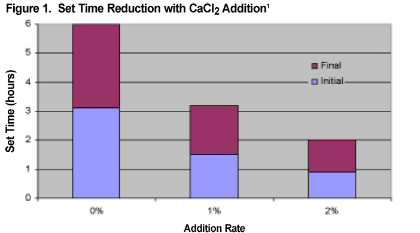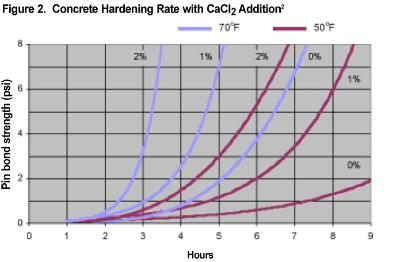Concrete Acceleration
Calcium Chloride in Portland Cement Concrete
Still the Most Effective Concrete Accelerator
Introduction


Scroll down for guidelines on the use of calcium chloride in Portland cement concrete. For more information, visit our web site at www.peterschemical.com, or contact The Peters Chemical Company Customer Information Group at 1-973-427-8844.
References:
- “Effect of Calcium Chloride on Portland Cements and Concretes.” Paul Rapp, Proceedings, Fourteenth Annual Meeting, Highway Research Board, (1934)
- “Measuring the Rate of Hardening of Concrete by Bond Pullout Pins.” T.M. Kelly and D.E. Bryant, Proceedings, ASTM, Volume 57, (1957)
It has long been known that curing concrete during cold weather can result in an inferior product with substandard properties. Curing also takes much longer, adding to job costs and extending the time before the concrete surface can be used. Although there are many types of accelerators, calcium chloride continues to be one of the most preferred. No other accelerator has been used so successfully for so long.
Why use Calcium Chloride?
Calcium chloride (CaCl2), has the ability to accelerate cement hydration and reduce set time by as much as two thirds. Research has shown that a 2% addition rate has an equivalent cure strength at 50°F as plain concrete at 70°F. Set times below 50°F will be longer, but the accelerated cure rate will still be greater than that of plain concrete.
In addition to the important contributions of cold weather protection and early strength of concrete, calcium chloride provides other benefits as well:
- Improves workability…regardless of mixture design, less water is required to produce a given slump when calcium chloride is used.
- Improves strength of air-entrained concrete…calcium chloride compensates for the reduction in strength with a higher cement factor concrete.
- Reduces bleeding…this is due to the early stiffening produced by acceleration and allows earlier final finishing.
These advantages combine to produce better quality concrete faster. Concrete acceleration with calcium chloride greatly facilitates completing jobs as quickly and economically as possible.
Guidelines for Using Calcium Chloride in Concrete
Table 1. Application Rates per Cubic Yard of Concrete
| Product | 5 Bag Mix 470 lbs. |
6 Bag Mix 564 lbs. |
7 Bag Mix 658 lbs. |
|||
| 1% | 2% | 1% | 2% | 1% | 2% | |
| LIQUIDOW™ 32% | 1.0 gal. | 2.1 gal. | 1.2 gal. | 2.5 gal. | 1.4 gal. | 2.9 gal. |
| DOWFLAKE™ 77-80% | 4.7 gal. | 9.4 gal. | 5.6 gal. | 11.3 gal. | 6.6 gal. | 13.2 gal. |
| PELADOW™ 90% | 4.0 gal. | 8.0 gal. | 4.8 gal. | 9.7 gal. | 5.6 gal. | 11.3 gal. |
Making Up Solutions
Calcium chloride dissolves easily in cold water with continuous agitation. Always add calcium chloride to the water; do not add water to calcium chloride. Never use hot or warm water to dissolve calcium chloride. Heat is released during dissolution. Avoid splattering hot solution. Allow the solution to cool before use.
Table 2 may be used as a guide in making up calcium chloride solutions from dissolving solid products in water. Simply multiply the quantities in the table by the desired number of gallons and then divide by 100.
Table 2. Examples of Solution Make-up Recipes – 100 Gallon Batches
| Product | 29% Solution | 32% Solution | 35% Solution | |||
| solids | water | solids | water | solids | water | |
| DOWFLAKE™ Xtra 83-87% | 366 lbs. | 85 gal. | 415 lbs. | 82 gal. | 465 lbs. | 80 gal. |
| ANHYDROUS 94-97% | 331 lbs. | 89 gal. | 375 lbs. | 87 gal. | 421 lbs. | 85 gal. |
Safety and Disposal Precautions
Reasonable handling, care and cleanliness, plus the use of safety goggles, should be sufficient to prevent contact when handling calcium chloride. When dissolving solid calcium chloride or handling liquid solutions, wear impervious protective clothing, such as rubber gloves, rubber boots, an apron and safety goggles. Avoid all contact with leather products. If calcium chloride comes into contact with skin, wash thoroughly with water. Wash contaminated eyes for 15 minutes with flowing water. Promptly seek medical attention for any on-going irritation or burning sensation. Wash contaminated clothing before reuse.
When cleaning out equipment flush with a copious amount of water, avoiding run-off into drinking supplies, plants, or shrubbery. The addition of water to the calcium chloride may adequately dilute its concentration to within acceptable limits for surface disposal as allowed by Federal, State, and Local regulations.
Sources of Additional Information
American Concrete Institute; ph: 248-848-3700; www.aci-int.org
Portland Cement Association; ph: 847-966-6200; www.cement.org
National Ready Mix Concrete Association; ph: 301-587-1400; www.nrmca.org
- Calcium chloride used as an admixture for concrete should meet the requirements of ASTM D98.
- The amount of calcium chloride used should not exceed 2% (Table 1) and preferably, should be added in solution form to the aggregates in the mixer drum or as a portion of the mixing water, reducing the total mixing water required by the amount of solution being used.
- When ready mixed concrete is used, calcium chloride should be added at the plant site if the concrete is to be discharged within one hour after the start of mixing. Otherwise, it should be added at the job site, mixing for at least three minutes or 30 revolutions of the mixer, whichever is longer.
- If dry calcium chloride is used, it should be added free of lumps to the aggregates in the mixer drum during mixing, or to the mixed concrete just before discharge.
- Concentrated calcium chloride should not come into direct contact with dry cement as it may cause flash set.
- For best results, calcium chloride application rates should vary with temperature as follows, (see Table 1):
- >90°F – no more than 1%
- 70°F to 90°F – 1.0 to 1.5%
- <70°F – up to 2%
- Never exceed 4% due to flash set probability
- Calcium chloride is classified as a Type C accelerating chemical admixture for concrete by ASTM C494. The specific effects produced by chemical admixtures may vary with the properties of the other ingredients in the concrete.
- If the contribution of admixed calcium chloride to corrosion of embedded metals is a concern, it is recommended that the most recent reports from the following American Concrete Institute committees be consulted for guidance on calcium chloride use under various exposure conditions.
ACI 201, Durability of Concrete
ACI 212, Admixtures for Concrete
ACI 222, Corrosion of Metals in Concrete
ACI 306, Cold Weather Concreting
ACI 318, Structural Concrete Building Code
Notice: No freedom from any patent owned by Seller or others is to be inferred. Because use conditions and applicable laws may differ from one location to another and may change with time, Customer is responsible for determining whether products and the information in this document are appropriate for Customer’s use and for ensuring that Customer’s workplace and disposal practices are in compliance with applicable laws and other governmental enactments. Seller assumes no obligation or liability for the information in this document. NO WARRANTIES ARE GIVEN; ALL IMPLIED WARRANTIES OF MERCHANTABILITY OR FITNESS FOR A PARTICULAR PURPOSE ARE EXPRESSLY EXCLUDED.
